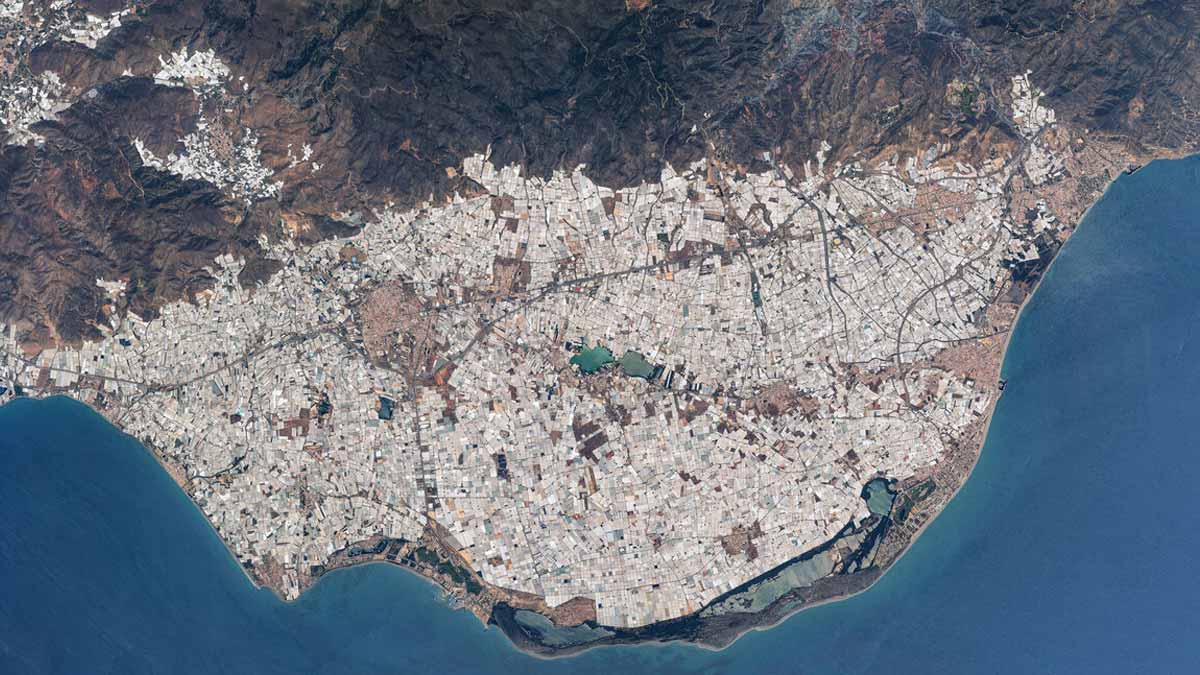A blinding white expanse flashes from orbit and unsettles certainties about what humans can build. Not a wall, not ancient stones, but a living system that bends light, water and time to feed millions. Hidden in Europe, it stretches like a mirror across dry ground, precise to the meter, relentless through seasons. Call it a construction with a pulse : a network that turns scarcity into yield and forces us to rethink scale, impact and responsibility—starting now.
Why this construction outshines famous monuments from orbit
From the International Space Station, a bright expanse glimmers across Europe’s southern border, and it captures attention immediately. Spanish astronaut Pedro Duque verified that this “ocean of plastic” stands among the most recognizable landmarks viewed from orbit, so aviators and researchers frequently employ it as a visual marker during flyovers.
The location is Almería, on Spain’s southeastern coast, where tens of thousands of hectares are roofed with plastic. The concentration around El Ejido and Campo de Dalías forms a continuous, reflective canopy that contrasts with the tawny Sierra and the dry plains, which makes the patchwork look almost metallic when the sun stands high above the Mediterranean.
These coverings accomplish more than gleaming; their elevated albedo deflects solar radiation upward, and scientists have connected the reflectance to minor regional temperature reduction. The climatic influence stays limited, yet it demonstrates how a concentrated artificial surface can influence thermal patterns while growers, technicians, and designers balance illumination, warmth, and humidity within.
From barren plateau to high-yield greenhouses
In 1959, entrepreneur José Hernández Buj adapted Belgian greenhouse ideas to Almería’s harsh conditions, and the prototype worked. Materials were cheap, frames were simple, and wind-resistant designs improved quickly, so neighbors copied the method. As plots multiplied, a coherent grid emerged, and a functional construction gradually overtook land once dismissed as marginal and unproductive.
Drip irrigation then transformed water use because it targeted roots and limited evaporation, while sand-mulch and white plastic tuned temperatures. Farmers controlled humidity and airflow with vents, so plants avoided stress during dry spells. Waste streams found structure through composting and substrate reuse, and the yields rose steadily, which reassured banks and co-ops that financed expansion.
The output speaks clearly. Today, between 2.5 and 3.5 million tons of food leave this area each year. Tomatoes, cucumbers, zucchini, and peppers feed European markets through winter, while logistics hubs connect fields to ports and highways. This steady supply supports jobs across packing, transport, and equipment, and it softens price swings that strain urban consumers.
Technologies that turned aridity into productivity
Precision matters inside every tunnel and multi-span house, and teams watch sensors because a few degrees change growth. Textured films tune diffusion, while shade nets temper radiative peaks, and localized fertigation keeps roots active. As practices matured, many growers cut chemical inputs, so certification schemes gained ground and opened doors to cautious retailers.
NASA Earth Observatory images track the greenhouses’ expansion and seasonality, and the record shows a clear, human-made signature from orbit. That record helps analysts compare years and map edges, while agronomists match spectral shifts to cropping patterns. Under this canopy, the operating logic looks like infrastructure, so the word construction fits the living, adjustable system.
Researchers now study transferable lessons because semi-arid belts expand under climate pressure. Enclosed cultivation improves water productivity, yet success depends on design choices, waste handling, and energy. Training, finance, and maintenance sit alongside agronomy, and the combination matters because weak links spill costs. As always, details decide whether methods travel well beyond Spain.
Numbers that explain a modern construction of agriculture
Scale defines visibility. More than 40,000 hectares are under plastic in Almería, and that size explains the orbital shine. The canopy’s geometry stacks reflectivity across a broad surface, so the patch reads like snow from space. Satellites quantify this brightness, and images help local planners monitor edges, zoning, and storm damage after rough seasons.
Output defines impact. Yearly output of 2.5–3.5 million tons ensures continuous supply, and it minimizes seasonal shortages throughout European markets. Tomatoes prevail, but cucumbers, zucchini, and peppers prove significant as well because variety strengthens revenue. Processing facilities incorporate refrigeration systems and tracking protocols, while distributors require certifications, so record-keeping, education, and inspections become integral to operational schedules.
Limits define responsibility. Plastic must be collected, recycled, or replaced under controls, and runoff needs barriers and reuse. Energy for pumping and cooling requires management, so solar arrays and efficient motors rise on roofs and yards. Within that effort, the region refines a working construction that balances yield, cost, and measurable environmental footprints.
What this experiment means for tomorrow’s food resilience
Climate change tightens the screws on water, heat, and soil, and Almería shows one path that leans on design. Covered systems stretch scarce resources, yet they demand vigilance, and they never run on technology alone. Governance, training, and fair market access sustain progress, while peer learning spreads practical fixes that stick.
Because criticism once targeted inputs and waste, producers moved toward cleaner protocols and stricter audits. That shift improved trust with buyers and neighbors, while public data helped separate myth from fact. When methods evolve, confidence grows, and investors back upgrades that cut losses, so the region compounds gains and attracts research funding across disciplines.
Almería functions like a living laboratory. Farmers test varieties as engineers tweak ventilation, and planners watch maps while processors fine-tune cold chains. The “sea of plastic” remains striking, but the deeper story is continuous adaptation. Under bright roofs, resilience becomes process, not slogan, and lessons move wherever land, water, and heat are in short supply.
What the white sea tells us about human choices today
This landscape proves that design, scale, and will can rewire outcomes, and the orbit-bright patch forces attention. It is a working system, not a museum piece, and it feeds cities while it evolves. As methods improve, this construction will keep testing limits and teaching restraint, so Europe’s brightest human mark doubles as a classroom.
